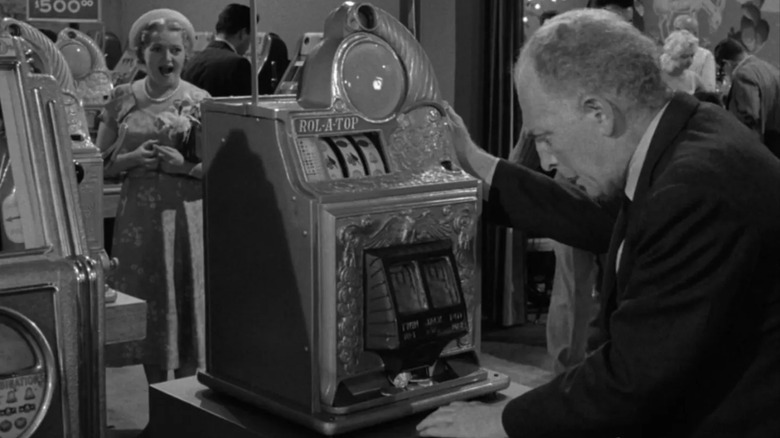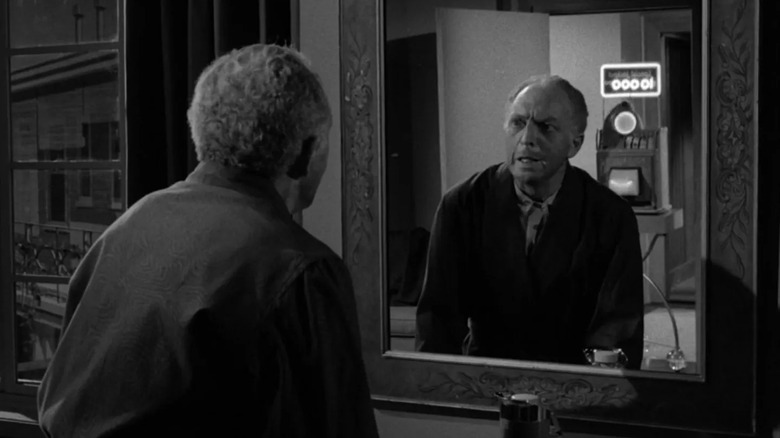One Twilight Zone Prop Was So Illegal It Came With A Police Escort
In the 1960 episode of "The Twilight Zone" called "The Fever," a puritanical man named Franklin (Everett Sloane) is taken to Las Vegas by his wife Flora (Vivi Janiss) as their prize for her having won a slogan-writing contest. Franklin wants nothing to do with Vegas, as he strenuously objects to gambling. Flora tries to get Franklin to gamble, but he sees no point. It's only after a vagrant offers Franklin a coin and a recommended slot machine that the story turns sinister. Franklin wins a $10,000 jackpot with a single pull.
Franklin is almost immediately stricken with a dark gambling addiction. At night, he treks back to the gambling floor — to the same accursed machine — in an attempt to win more money. He says that he wants to get rid of the "tainted" funds he won from a game of chance, but he clearly has, well, The Fever. Eventually, Franklin becomes convinced that the machine is sentient, and he hallucinates the one-armed bandit appearing to him in a hallway, scooting in his direction, laughing at his lack of control. Was the machine a demonic entity, or was "The Fever" a mere portrait of gambling addiction?
"The Twilight Zone" was filmed largely in Southern California at the Metro-Goldwyn-Mayer studios in Culver City, while desert scenes were shot in Yuma, Arizona. As it so happens, gambling was — and is — illegal in California (apart from Bingo halls and horse racing). This is why trips from L.A. to Las Vegas are so common; slot machines are legal in Nevada.
Special dispensation, then, needed to be made to secure a slot machine for the filming of "The Fever," According to Marc Scott Zicree's book "The Twilight Zone Companion," the machine required a constant police supervisor.
The infernal machine
Producer Buck Houghton, who oversaw over 100 episodes of "The Twilight Zone," recalls what he and the prop department had to do to get an actual slot machine. They couldn't build one, as even a facsimile of a slot machine was illegal. It seems that Houghton had to contact the local police department to see if any slot machines had been seized recently. Luckily, it seems that at least one of them had been. Houghton said:
"Gambling machines were illegal in California. A prop house couldn't even have them. So we had to get one-armed bandits from the police department where they were impounded. It was just like a machine gun, you had to have a policeman along with it. There was a policeman on the set at all times, to make damn sure that somebody didn't take one off and set it up in his uncle's barber shop."
Keep in mind that anti-gambling ordinances were incredibly strict, even to the point of banning pinball machines in the 1930s. Early pinball machines, recall, had no flippers and operated more like pachinko machines. Players would launch balls into prize-winning pockets — constructed of nails or pins — on the playing board. It wouldn't be until 1974 that pinball machines would be made legal again.
The slot machine in "The Twilight Zone," then, was a real-life model that could have been found in illegal casinos during the Depression. The machine was a Rol-A-Top brand device manufactured by the Watling company. It was only produced from 1935 to 1938. Ambitious collectors can still find Rol-A-Tops online for a hefty price. The "$10,000 jackpot" neon sign seen on "The Twilight Zone" was an additional prop added by the show's own production designers.

